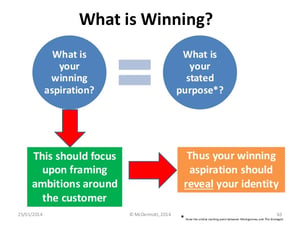 Great strategy is making choices.
Great strategy is making choices.
Clear, tough choices.
Most business never fully consider these Strategy choices:
- What businesses are you in?
- Which are you not in?
- Where will you play in the businesses you choose to be in?
- How you will win where you play?
- What capabilities and competencies you will turn into core strengths?
- How will your internal systems turn those choices and capabilities into consistently excellent performance in the marketplace?
Strategy Step One: Create a Winning Aspiration
Aspirations are statements about your ideal future.
What is your winning aspiration?
“A Winning Aspiration defines the purpose of your enterprise, its guiding mission and aspiration, in strategic terms.” ~ AG Lafely & Roger Martin, Playing to Win; How Strategy Really Works
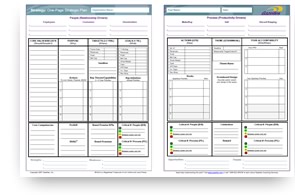 In ScaleUp’s One Page Strategic Plan, your winning aspiration is defined as your Core Purpose. Simon Sinek shares this concept in his Ted Talk, and book Start With Why. We shared his and ours ideas Strategic Core Purpose in Want To or How To: People & Core Purpose.
In ScaleUp’s One Page Strategic Plan, your winning aspiration is defined as your Core Purpose. Simon Sinek shares this concept in his Ted Talk, and book Start With Why. We shared his and ours ideas Strategic Core Purpose in Want To or How To: People & Core Purpose.
Do you have a winning aspiration?
Take a look at the three examples for McDonalds, Nike, and Starbucks.
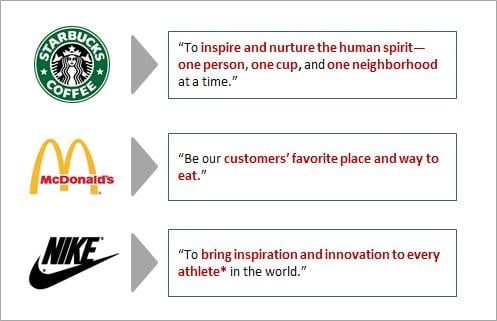 What does winning look like for this organization?
What does winning look like for this organization?
What, specifically, is your businesses strategic aspiration?
The answers is the foundation for your strategy. It sets the context for all the strategic choices that follow.
We’ll tie your aspirations to specific benchmarks to measure your progress as we move through the Playing to Win Strategy Process.
Expressing Your Aspiration
Peter Drucker argued that the purpose of an organization is to create a customer. Lafely recommends this as where to start. Look at the examples above. Starbuck’s, Nike, and McDonalds frame their ambitions around their customers.
Nike wants to serve every athlete (not just some of them); McDonald’s wants to be its customers’ favorite place to eat (not just a convenient choice for families on the go).
“Each company doesn’t just want to serve customers; it wants to win with them. And that is the single most crucial dimension of a company’s aspiration: a company must play to win. To play merely to participate is self-defeating. It is a recipe for mediocrity. Winning is what matters—and it is the ultimate criterion of a successful strategy. Once the aspiration to win is set, the rest of the strategic questions relate directly to finding ways to deliver the win.” From Playing to Win: How Strategy Really Works:
The Importance of Winning
Why is it important to make winning an explicit aspiration?
Winning is worthwhile because a significant proportion (frequently a disproportionate share) of industry value-creation accrues to the industry leader.
It comes with this caveat though:
Winning is hard. It takes hard choices, dedicated effort, and substantial investment.
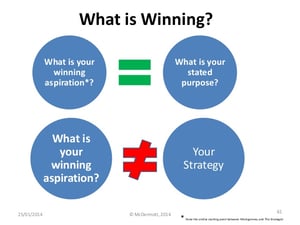 Lots of companies try to win and still can’t do it.
Lots of companies try to win and still can’t do it.
It’s impossible to win unless you explicitly set out to do so. When a company sets out to participate, rather than win, it will inevitably fail to make the tough choices and the significant investments to make winning possible. (In playing to win, Lafley shares the story of GM’s $20 Billion Saturn mistake to illustrate this point. In contrast he shares Filippo Passerini, president of P&G’s global business services (GBS) unit, decision to select several BPO’s-business process outsourcer as an example of how playing to win guided his choice in making a winning move.)
A too modest aspiration is far more dangerous than a too-lofty one. Most companies die due to modest aspirations.
What Business Are You In?
Asked what business you’re in, most businesses CEO’s will tell you what their product line is or will detail their service offering. A handheld phone manufacturer, for example, would say they are in the business of making smartphones. They would not say they are in the business of connecting people and enabling communication any place, any time. That is actually the business they are in. A smartphone is just one way to accomplish that.
 Economist Theodore Levitt identified a half-century ago a danger alive still today. Companies in the grips of marketing myopia are blinded by the products they make and are unable to see the larger purpose or true market dynamics.
Economist Theodore Levitt identified a half-century ago a danger alive still today. Companies in the grips of marketing myopia are blinded by the products they make and are unable to see the larger purpose or true market dynamics.
Think of a skin-care company. It is far more likely to say it makes a line of skin-care products than to say it’s in the business of helping women have healthier, younger-looking skin. It’s a subtle difference, but an important one.
What business are you truly in?
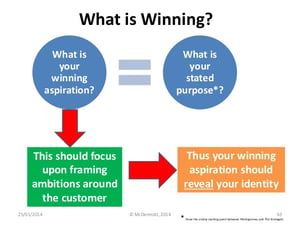 Your biggest danger is to focus on the wrong things—your materials, engineering, and chemistry. It takes you away from the consumer. Winning aspirations should be crafted with the consumer explicitly in mind. The most powerful aspirations will always have the consumer, rather than the product, at the heart of them.
Your biggest danger is to focus on the wrong things—your materials, engineering, and chemistry. It takes you away from the consumer. Winning aspirations should be crafted with the consumer explicitly in mind. The most powerful aspirations will always have the consumer, rather than the product, at the heart of them.
COMPETITION
When setting winning aspirations, you must look at all competitors, not just at those you know best. Start with the usual suspects. Look at your biggest competitors, your historical competitors. At P&G, they are Unilever, Kimberly-Clark, and Colgate-Palmolive. Expand your thinking. Focus on the best competitor in your space, looking far and wide to determine just who that competitor might be.
In P&G’s case the best competitors were found to be local companies, private-label competitors, and smaller consumer-goods companies. P&G’s home-care team came to focus on Reckitt-Benckiser.
ASK
- Who really is your best competitor?
- What are they doing strategically and operationally better than you?
- Where and how do they outperform you?
- What could you learn from them and do differently?
Looking at the best competitor, no matter which company it might be, provides helpful insights into the multiple ways to win. This is why I use Kaihan Krippendorff’s 8 P’s Outthinker Score to help my customers identify their real strengths and weaknesses. It requires you to look at your business versus your competition.
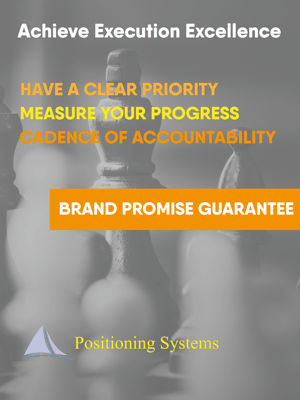 Growth demands Strategic Discipline.
Growth demands Strategic Discipline.
The 3 Strategic Disciplines: Priority, Metrics and Meeting Rhythms help your business dramatically improve your forecasting, and alignment. It empowers your team to achieve accelerated growth. Strategic Discipline paves the road to success on your 3-5 year plan.
Strategy Decisions should result in top line revenue growth. Positioning Systems helps you navigate and determine your best strategy for your future growth. With experts like Kaihan Krippendorff (Outthinker Process) we bring superior experience to elevate your Strategy decision-making.
Positioning Systems helps your business achieve these outcomes on the Four most Important Decisions your business faces:
|
DECISION |
RESULT/OUTCOME |
|
PEOPLE |
|
|
STRATEGY |
|
|
EXECUTION |
|
|
CASH |
|
We help your business achieve Execution Excellence.
Positioning Systems helps mid-sized ($5M - $250M) business Scale-UP. We align your business to focus on Your One Thing! To achieve growth, you need to evolve in today’s rapidly changing economic environment. Are you avoiding a conversation with yourself on how to can successfully grow your business? Contact dwick@positioningsystems.com to Scale Up your business! Take our Four Decisions Needs Assessment to discover how your business measures against other Scaled Up companies. We’ll contact you.
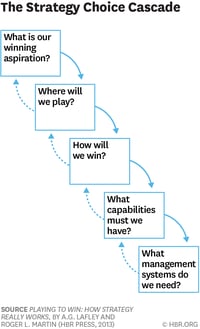 PLAYING TO WIN – WHERE TO PLAY
PLAYING TO WIN – WHERE TO PLAY
A.G. Lafley feels most leaders do not like to make choices. They’d rather keep their options open. Choices force their hands, pin them down, and generate an uncomfortable degree of personal risk. I’ve also found that few leaders can truly define winning. The next step in defining your Strategy is to determine Where to Play. We’ll explore this next blog.






.jpeg?width=150&height=135&name=Hand%20with%20marker%20writing%20the%20question%20Whats%20Next_%20(1).jpeg)

